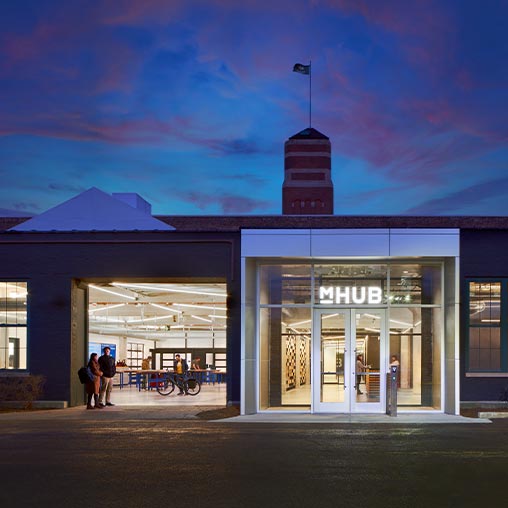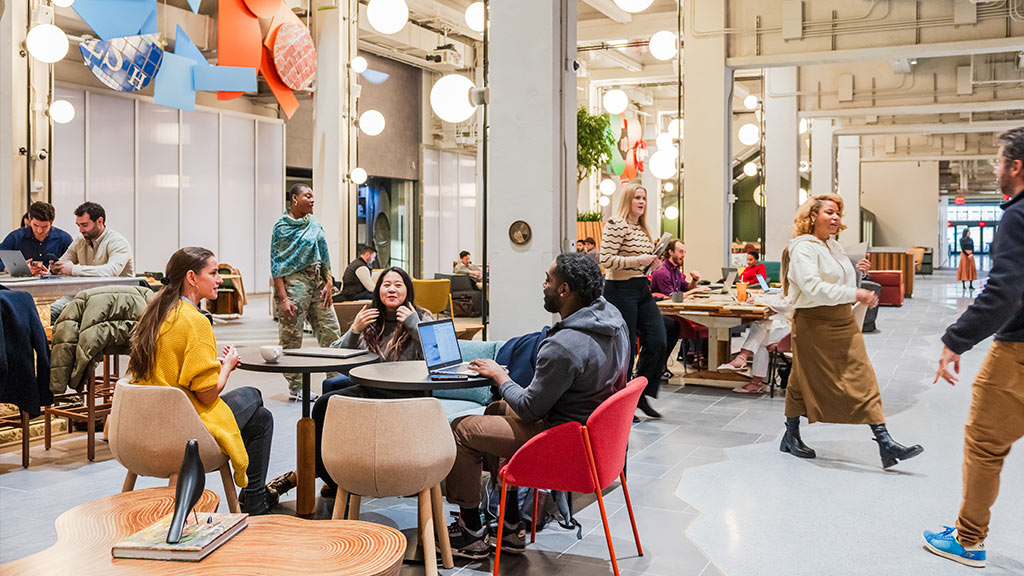Technology
We design spaces for technology companies of all sizes seeking to grow, perform better, and retain top talent; our projects enable clients to support all work modes while advancing wellness and ESG goals.
“
We designed a flexible workplace ecosystem with an adaptable mix of work settings, amenities, gathering areas, green spaces, and relaxation zones that create a uniquely Google experience — one that will only get better with time.
—Amanda Carroll, Principal
27 Items

NVIDIA
Santa Clara, California
The Silicon Valley pioneer NVIDIA sought a corporate headquarters that reflected its core belief in people as its greatest asset.

Adobe Founders Tower
San Jose, California
Adobe’s Founders Tower embodies the company’s commitment to creativity, sustainability and inclusivity, and takes an innovative approach to the future of work.

Celonis
Munich, Germany
Gensler collaborated with Celonis on the design of its customer-centric Executive Briefing Center in Munich, which provides exclusive access and insights.

Synopsys Munich
Munich, Germany
Synopsys’ Munich office redefines the tech workplace with a sustainable and hospitality-inspired design, supporting talent attraction, wellbeing, and modern, high-performance workstyles.

Confidential Technology Client
Portland, Oregon
This bright, cheerful office space was designed for a confidential technology client located in downtown Portland.

Index Exchange
Toronto, Ontario
Responsive and flexible, Index Exchange’s workplace at The Well in downtown Toronto, is designed for the employee — however and wherever they choose to work.

Etsy Dublin
Dublin, Ireland
Etsy enlisted Gensler to create a transformative, community-driven workspace in Dublin that brings the brand and its collaborative work culture to life.

IBM Flagship Office at One Madison Avenue
New York, New York
The new workplace has become an empowering platform for IBM’s formerly distributed teams because of its client-centric amenities and team-focused collaboration and meeting spaces.

Pinterest Mexico City
Mexico City, Mexico
Pinterest Mexico City seamlessly integrates client vision and cultural inspiration, creating a vibrant celebration of Pinterest’s essence and Mexico’s heritage.

Atlanta Tech Village – Sylvan
Atlanta, Georgia
Atlanta Tech Village Sylvan is designed to serve creative entrepreneurs of all kinds and bring renewed energy to a long overlooked heart of downtown.

Google at St. John’s Terminal
New York, New York
St. John’s Terminal is a sustainable 12-story workplace designed as Google’s Global Business Organization headquarters located in Hudson Square in New York.

Workday Beaverton Expansion
Beaverton, Oregon
The Gensler team reimagined the Workday Beaverton workspace to evoke a comforting “home away from home” ambiance.

KAYAK
Berlin, Germany
KAYAK partnered with Gensler on the travel-inspired design of its new office at Warschauer Straße in Berlin.

Amazon HQ2 Metropolitan Park
Arlington, Virginia
Amazon HQ2’s new East Coast home base is designed by Gensler to house more than 14,000 employees in Arlington, Va., just minutes from the heart of downtown D.C.

LinkedIn Atlanta
Atlanta, Georgia
LinkedIn Atlanta’s workplace reinforces company values, unites employees, and leverages office neighborhoods to create unique settings for different workstyles.

Adobe White Collar Factory, London
London, United Kingdom
Adobe collaborated with Gensler to design an expansion of their original Shoreditch location at the White Collar Factory in London.

mHUB Chicago
Chicago, Illinois
mHUB, a leading hardtech & manufacturing innovation center, worked with Gensler to convert a historic Chicago warehouse into its headquarters.

Verizon Innovation Center
San Francisco, California
Verizon envisioned a dynamic hub with a best-in-class Innovation Center and workplace to inspire employees and immerse partners in the company’s technologies.

T-Mobile Headquarters Campus
Bellevue, Washington
T-Mobile’s renovated campus headquarters encompasses over 1,000,000 square feet of workspace designed to promote innovative strategy and collaboration.

Meta – Park Tower
San Francisco, California
The 760,000-square-foot vertical campus, located in the heart of downtown San Francisco, supports the 4,000 workers who are seated here daily through a modern design that promotes Meta’s forward-thinking culture.

Confidential Software Company
Tokyo, Japan
To signify this software company’s introduction to the Japanese market, a distinctive maritime theme is woven throughout its new branded workplace in Tokyo.

SAP Group
Tokyo, Japan
SAP’s new Tokyo office adds to SAP’s campus ecosystem that accelerates innovation and collaboration with clients and partners and supports hybrid work.

Emerson-NI Pilot Program
Austin, Texas
Emerson-NI, a company that creates automated test equipment and virtual instrumentation software, is working with Gensler to renovate its workplace campus.

Insight Headquarters
Chandler, Arizona
Gensler worked collaboratively with Insight to create a vibrant, connected workplace that serves as a true embodiment of their entrepreneurial culture.

Gravie
Minneapolis, Minnesota
Gravie, a rapidly growing technology company, expanded to a new, larger home to support its highly collaborative and flexible hybrid work model.

Toronto, Ontario
Pinterest enlisted Gensler to create a transformational workplace representative of its brand identity, company values, and collaborative culture.

LinkedIn Omaha
Omaha, Nebraska
LinkedIn partnered with Gensler to design its new 200,000-square-foot campus in Omaha, Nebraska — the first portfolio project embracing LinkedIn’s Future of Work Strategy, developed alongside Gensler.
INSIGHTS

Blog
Debunking 3 Myths About Generational Differences in the Workplace
As generational differences narrow, organizations should focus their workplace strategies across the entire talent spectrum

Blog
How the Future of Work Is Influencing Workplace Design
While workplace design changes incrementally, the past few years radically transformed our expectations of an office and how we can design for what’s possible.

Blog
The New Club Workplace: More Than an Amenity
The next generation of tenants wants an experience-driven, unconventional shared amenity space, prompting landlords to rethink their offerings.

Blog
The New Workplace Experiences That People Crave
Employees want to move past the corporate workplace experience to more creative, natural, and residential environments.

Blog
It’s Time for the Traditional Conference Room to Make Way for New Spaces
It’s time to forgo the traditional conference room and make space for more intentional, adaptable environments that are aligned with how people connect today.

Blog
How Summer FOMO Is Shaping the Canadian Workplace
Our latest research offers some insights into why a desire for flexibility, variety, and seasonal adaptability is influencing the workplace in Canada.

Blog
Agency Is the New Workplace Amenity
By designing enough of the right spaces within the workplace, employers can create environments where employees have agency to choose the best space for their needs.

Blog
The Convergence of Tech and the Financial Workplace
The financial workplace is taking cues from the tech industry, shifting from one-size-fits-most to always-in-beta mode.

Blog
Why Now Is the Time for a Workplace Reset
To keep pace with changing workforce expectations, we need to think differently about the workplace.

Research
Global Workplace Survey 2025
Gensler’s Global Workplace Survey 2025 reveals the importance of in-person work and insights on how workplaces can be better designed to support all forms of work for individuals and teams.

Blog
Bandwidth Headquarters: A Workplace Designed Not Just for Work, But Life
An amenity-forward design approach cultivates a vibrant and dynamic workplace environment, empowering every employee to perform at their peak potential every day.

Blog
What’s Next for the Workplaces of San Francisco?
As the city’s office market navigates recovery, landlords, building owners, and employers must consider the varying needs of future real estate vs. the status quo.

Blog
The Next Big Generation at Work May Not Be Who You Think
Historically, the fastest growing age group in the U.S. workforce has always been the upcoming generation. But not anymore.

Blog
Repopulating the Workplace: Why Collaboration Space Is in Danger
Despite their value, collaboration spaces are often the first to go when companies are looking for ways to repopulate the workplace.

Blog
What Are Corporate Real Estate Executives Planning for 2025?
A look at what office space portfolio modifications and space allocation strategies CRE leaders are anticipating and planning for the year ahead.
Trends in Technology
AI companies build community within the workplace.
A growing number of people are relocating to work for AI startups, spurring these companies to invest in hospitality-infused experiences that can foster a sense of belonging and act as community hubs.
Tech employers get more involved in the neighborhood.
To demonstrate good corporate citizenship, tech companies can explore public-private partnerships that invest in local businesses to create jobs, alleviate housing shortages, and develop new talent.
Upskilling and training workers and vendors redefines the tech workplace.
As AI disrupts the industry, some tech companies are focusing on zone-based approaches to office planning to examine how different zones in the workplace can support new skills and training.

TECHNOLOGY LEADERSHIP

Erin Greer
Technology Leader, Strategy Leader, Principal
Erin Greer is a global leader who oversees the design of creative spaces that support the future of work for the sector’s top companies and talent.

Kelly Dubisar
Technology Leader, Principal
Kelly Dubisar is an award-winning Design Director and global leader of Gensler’s Technology practice.
NEWS

In The Media
![]() Interior Design Magazine
Interior Design Magazine
Google at St. John’s Terminal Wins Interior Design Magazine’s 2024 Best of Year Award
Interior Design named Google at St. John’s Terminal a Best of Year Award winner in the “Large Tech Office” category, highlighting its “sensory-rich physical spaces,” flexible work areas, biophilia, and hospitality-infused spaces.
March 10, 2025

In The Media
![]() Forbes
Forbes
Gensler’s Brian Stromquist and Meaghan Beever Discuss Designing for a Neurodiverse Workforce
Stromquist explains why “we baseline design for inclusivity from the beginning of every project” to create spaces of solace and safety in the office.
November 24, 2024

In The Media
![]() Work Design Magazine
Work Design Magazine
Work Design Magazine Toured Celonis’ Executive Briefing Center
Customers have the opportunity to meet the Celonis team and innovate and ideate together in the tech start-up’s newly designed space in Munich, designed by Gensler.
October 29, 2024

In The Media
![]() Newsweek
Newsweek
Newsweek Highlighted IBM’s New NYC Hub With Insights From Gensler Managing Director Amanda Carroll
The feature examines the role that office design plays in creating a destination that draws workers back, and how Gensler worked with IBM on the real estate strategy.
October 20, 2024

In The Media
![]() The New York Times
The New York Times
The New York Times Explores the Ongoing Transformation of New York’s Hudson Square Neighborhood
Gensler Managing Director Amanda Carroll detailed the firm’s work on Disney’s new headquarters and Google’s new home at St. John’s Terminal in Hudson Square, noting the benefits of ample access to outdoor spaces.
October 05, 2024

In The Media
![]() Business Insider
Business Insider
Business Insider Rounded Up the Coolest Tech Offices of 2024, Featuring NVIDIA’s “Futuristic Headquarters”
The article quoted Gensler Principal Hao Ko, who explained the design concept is “rooted in that idea that people do their best work when they are provided with a choice.”
August 12, 2024

In The Media
![]() The Wall Street Journal
The Wall Street Journal
The Wall Street Journal Took a Video Tour of Google at St. John’s Terminal in New York City
Gensler Managing Director Amanda Carroll highlighted Gensler’s design for Google’s neighborhood-based future of work model.
July 25, 2024

In The Media
![]() Success Magazine
Success Magazine
How Workplaces Are Incorporating Spaces for Play and Creativity for All Generations
Gensler’s Natalie Engels discussed the role of play at work “to create balance and team building” and provide “activities that increase employee happiness, reduce cognitive load, increase tenure, and lead to higher productivity.”
June 13, 2024

In The Media
![]() Business Insider
Business Insider
NVIDIA Headquarters Featured in Business Insider’s Coolest Offices of Big Tech Firms
Design Principal Hao Ko believes that “by refining the design of the workplace based on how people use it, we will continue to drive more innovation and a more resilient future.”
March 30, 2024

In The Media
![]() Business Insider
Business Insider
Business Insider Toured Google’s New York HQ, Located in a Converted 1930s Train Station
Gensler Co-Managing Director Carlos Martínez Flórez noted that Google “wanted to show that this building is part of New York.”
March 09, 2024

In The Media
![]() Curbed
Curbed
Curbed Featured the Recently Revealed Google’s St. John’s Terminal in NYC
Architecture critic Justin Davidson noted that “Gensler has designed an indoor city with looping streets, unexpected plazas, and rooms for every work style, from the conference-table meeting to the slouch-and-hang.”
February 26, 2024

In The Media
![]() Bloomberg
Bloomberg
Three Office Design Predictions for 2024, According to Gensler’s Design Forecast
Gensler Principal Natalie Engels explained why companies are focusing more on the well-being of the teams and individuals and detailed Gensler’s recent project work across industries.
December 19, 2023

In The Media
![]() Interior Designers of Canada
Interior Designers of Canada
Gensler’s Design of Index Exchange’s New Workplace Recognized by the Interior Designers of Canada
Interior Designers of Canada honored Index Exchange among the winners of its 2023 Value of Design Awards.
December 15, 2023

In The Media
![]() Business Insider
Business Insider
Inside NVIDIA’s Voyager Headquarters, a ‘Futuristic Office’ Designed by Gensler
Business Insider explored how NVIDIA’s headquarters was designed to enhance productivity, connect people with nature, and reflect the company’s “no barriers and no boundaries” philosophy.
November 19, 2023

In The Media
![]() Propmodo
Propmodo
Adobe’s Founders Tower “Offers a Preview of the Future of Creative Office Space”
Gensler’s Natalie Engels detailed the building’s focus on sustainability, well-being, and amenities, including a public digital experience center.
August 18, 2023

In The Media
![]() The Washington Post
The Washington Post
Exploring the Past and Future of the Office
The Washington Post curated a visual timeline of how workplaces have evolved over the past 100 years, featuring workplaces designed by Gensler for LinkedIn Omaha and NVIDIA.
April 13, 2023